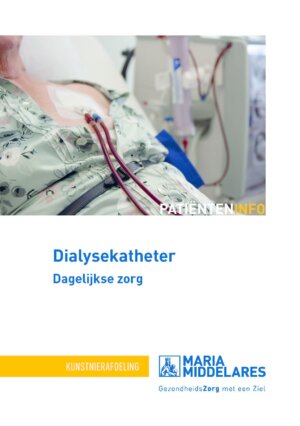Dialysis catheter
What is it?
What is it?A dialysis catheter is a plastic tube that is placed in a large blood vessel.
- The catheter can be placed as temporary access to the bloodstream. This happens whilst waiting for an arteriovenous fistula to be ready for use, for example.
- The catheter can also serve as a permanent access route if an AV fistula cannot be placed. The permanent dialysis catheter has a subcutaneous cuff. This is a thickened with Dacron (felt) cuff to promote firmness and prevent ascending infection. In the first weeks after placement, the permanent catheter is adhered to the skin with a suture. This means that the catheter cannot move and the cuff will have the opportunity to grow firmly into place.
The physician decides which dialysis catheter is the most suitable for you and provides the best results.
Placement of a dialysis catheter
Placement of a dialysis catheter- Temporary dialysis catheter: placed under local anaesthetic by a nephrologist.
- This is usually done in a neck vein or a vein under the collarbone. This is either a jugular or a subclavian catheter.
- Blood vessels in the groin can also be used for this purpose. They are known as a femoral catheter.
- A temporary dialysis catheter is usually placed in the dialysis department.
- Permanent dialysis catheter: is placed under local anaesthetic or mild general anaesthetic by the nephrologist or vascular surgeon.
- This usually happens in the dialysis department itself, in the radiology department or in the operating theatre.
The catheter bandage
The catheter bandageWhen you are in the dialysis ward for your treatment, dialysis nurses and physicians will pay special attention to the dialysis catheter to prevent infections. The dressing is applied so that the catheter cannot move inward and at the same time, is protected against external impacts. The catheter bandage consists of a part that covers the insertion site and a part that wraps around the tip of the catheter.
Sterile dressings will be applied and they may only be handled by the dialysis nurses. This is done on a weekly basis or more frequently, as required.
When there is no dialysis happening, the clamps on the dialysis catheter must always remain closed and the caps must always remain in place. Only staff from the dialysis department may use your catheter to draw blood or to administer medication or fluids.
Checking the dressing
The bandage around the tip of the catheter is loosened for each dialysis session so that the catheter can be connected to the bloodlines of the dialysis machine. The dressing at the insertion site of the catheter is usually replaced once a week by the dialysis nurses unless it causes irritation, has come loose or is dirty.
Check the outside of the bandage daily for dirt, pus or blood yourself. A soiled bandage may indicate the onset of infection. Be sure to mention this to the dialysis nurses or nephrologist.
Self-care of dialysis catheter
Self-care of dialysis catheterIt is important that you carefully look after your dialysis catheter yourself, including when you are away from the Dialysis Department. In this way, you take care of your health directly yourself.
Remember the following:
- Make sure you wear comfortable clothing on the day of your dialysis treatment. Clothing must have a wide neck or buttons. This will allow the nurses to handle your catheter better and replace the dressing more easily.
- Ensure that the catheter bandage is adhered properly and always remains clean and dry. If you want to take a shower, the catheter must be covered with a plastic covering. If your catheter bandage is wet, it must be replaced as soon as possible. You need to come to the dialysis department to have this done. After a shower, your dialysis catheter must always be cared for during the next dialysis treatment.
- Make sure that the dialysis catheter is not pulled during your daily activities or while dressing and undressing. If you feel that your clothing catches on something: do not pull on it, as that may pull out the catheter.
- If you notice that the catheter is no longer covered by a catheter bandage or shows signs of infection, contact the dialysis centre. Possible signs of infection are fever, shivering, redness, feeling warm, pain and the presence of fluid or pus near the catheter.
Leaflet
LeafletSee the leaflet below for more information on the dialysis catheter and possible complications.
Only available in Dutch:

Dialysekatheter
DownloadCentres and specialist areas
Centres and specialist areas
Latest publication date: 16/05/2024
Supervising author: Dr De Vleeschouwer Mieke



